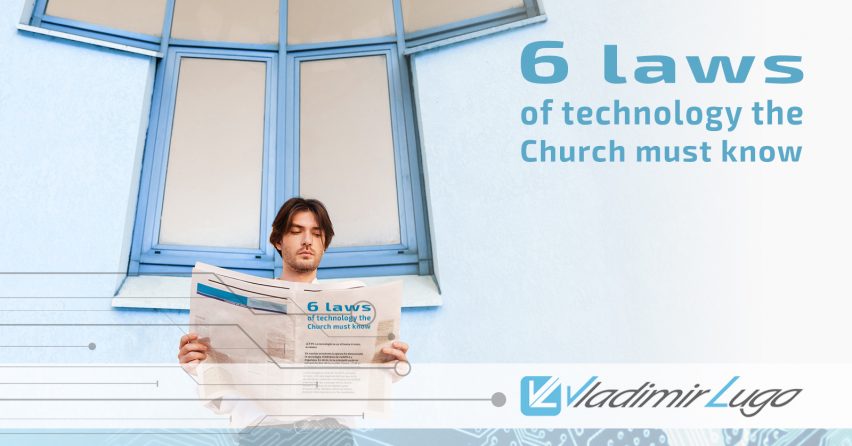M
elvin Kranzberg was an American historian and professor at Georgia Institute of Technology (Georgia Tech). He served as an interrogator during World War II under General Patton and helped locate numerous Nazi weapons caches.To Kranzberg, reviewing the technological history was essential. The history of technology not only helps us to differentiate between peacetime and wartime, but to analyze the impact that technology has had on the entire culture.
Whatever is has already been, and what will be has been before; and God will call the past to account.
Ecclesiastes 3:15
As such, egocentric history has the uncontrollable habit of repeating itself. That is why the Church needs to utilize technology for its ministry and must know the history of technology within ministry, and, according to Kranzberg, follow the lessons of such history, distilled into these 6 laws of technology the Church must know.
LAW #1: Technology is neither good, bad, or neutral
On many occasions, the Church has demonized technology. It has labeled it as evil and deceitful. In others, it has endowed it with supernatural powers, which it lacks. Where is the balance? We will find it in the first law.
Technology is amoral. That is, it is neither good nor bad, but rather, it depends on the use that it is given. It does not have inherent evil nor kind qualities. However, it is not neutral, either, because it is not lifeless and goes unnoticed. It always has an effect. It always has influence on the results. You can read more about the amorality of technology here.
Technology within the Church can produce beneficial results or unleash harmful consequences. It all depends on defining clear purposes and keeping our eyes open to evaluate and correct the course when needed.
LAW #2: Invention is the mother of need
This phrase is better known and appreciated among technophiles as “need is the mother of invention,” and was coined by Hugh, a monk at the monastery at Saint Victor, during the middle ages.
Kranzberg reverts this phrase to indicate that all technology creates its own needs and requires a constant application of other technologies to aid it.
When you apply technology to the Church, think about what other technologies you need to make the entire system functional. For example, microphones need stands, cables, consoles, and electricity; otherwise, they will not work.
LAW #3: Technology comes in big and small packages
The third law of technology is a direct consequence of the second. If you think systematically, soon you will discover that it requires other technologies: small ones (batteries) and large ones (power grid) to work.
This is the law of technological interdependence and interaction. Every technological element depends on others and needs to interact with them to achieve its goals. This is a great metaphor for the functioning of the Church itself.
Do not implement technology in the Church without considering the entire system, including the total costs of property and maintenance. Oh, if only the Church could learn to be interdependent and interactive!
LAW #4: Non-technical factors precede political decisions
All technologies must consider the political framework in which they operate. In fact, I consider that policies, which regulate and govern technologies, make up one of the five columns that define it. See my definition of technology here.
This law means: do not base regulatory decisions on technical capabilities. Rather, consider those factors causing long-lasting impressions on people and culture.
For the Church, this law is fundamental since the mission of the Church must be guide the decision-making process regarding technology, and not the other way around. Technology does not define its mission, but its mission must define technology. More on this here.
LAW #5: History is relevant, but the history of technology is even more
This is the law of impact. To Kranzberg, nothing has transformed and changed the course of history the way technology has.
A preceding technology can unchain a series of events that promote the creation of new technologies that lead to new events; hence the cycle. Therefore, the study of the history of technology is crucial in order to understand its direction and the cultural changes it entails.
The Church cannot pull away from the influence of technology if it attempts to stay relevant to its culture. There have been times in history when the Church was even at the forefront of this cycle. Could it be possible to reassume this position?
LAW #6: Technology is a human activity and so is its history
I always say, “Technology is by the people and for the people.” In other words, human beings create it for human beings to use it.
The benefit, or drawback, of technology depends on us, human beings. The continuity or rupture of technology and its history also depends on us human beings. It means that we have a stake, voice and vote, in the use of technology, personally, in our families, in the Church, and within society.
It is indispensable that the Church participate in the discourse of technology. Its use, application, and results, but in its innovation, regulation, and transformation as well.
If you think this article has been useful to you, please share it with a friend, and leave a comment in the blog and the various social media channels.










Leave a Reply